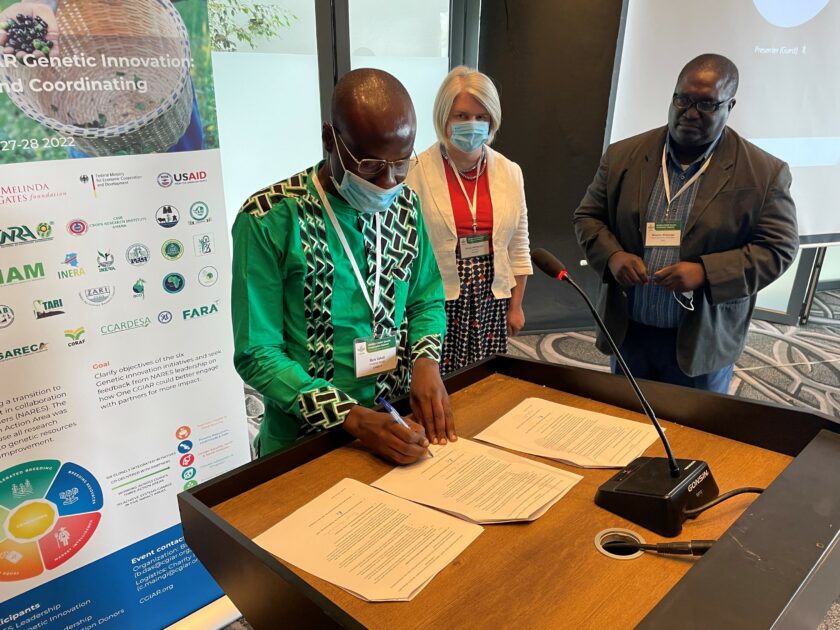Five ways CGIAR accelerated crop breeding in 2022
-
From
CGIAR Initiative on Accelerated Breeding
-
Published on
05.01.23
- Impact Area
-
Funders
Australia, Gates Foundation, Germany, United Kingdom, United States of America

But we’ve seen a year of major progress under the new One CGIAR structure. The Accelerated Breeding Initiative (ABI) and Excellence in Breeding (EiB) Platform have continued to push big steps toward program modernization that drives impact in farmers’ fields. The aim is to develop better-performing, farmer-preferred crop varieties and to decrease the average age of varieties in farmers’ fields. Here are five significant milestones that are helping CGIAR and its national partners improve the productivity, sustainability, and resilience of crops in the developing world:
1. Pipeline data and improved decisions: After describing the portfolio of breeding pipelines in 2021, EiB/ABI improved the data collection and analysis, enabling managers and breeders to take a critical look at how both germplasm and resources are managed for maximum impact. Before this work, breeders operated without a complete understanding of the market segments and their potential opportunities and impacts. But now CGIAR has the baseline data to ensure investments are targeted toward market segments with the greatest potential for impact. These include regions in Africa most in need of climate-resilient and nutritious varieties to feed growing populations.
2. Development of a common framework for aligning breeding with impact: The teams have worked across CGIAR to create a common framework for aligning the breeding process with impact across crops and institutions. This includes clear stage-gates, handover criteria, key performance indicators, and defined roles and responsibilities for achieving planned results. This helps realign breeding activities and teams to be more effective, efficient, and agile.
3. Aide Memoire outlining vision for CGIAR, NARES, and SROs: ABI/EiB spurred a process to develop an Aide Memoire outlining the vision for collaboration between CGIAR, NARES (national agricultural research and extension systems), and SROs (sub-regional organizations). The work better defines both technical breeding and partnership goals through the establishment of NARES-CGIAR-SME breeding networks. This refreshed relationship will help national programs adopt the best technologies and approaches – and ensure they move forward as equal partners to meet the needs of our farmers and populations.

4. Trait discovery and development work within CGIAR: ABI/EiB has created a comprehensive view of trait discovery and development (TD&D) work within CGIAR, which plays a critical role in the upstream breeding process. This includes identifying and characterizing important agronomic traits, such as drought tolerance or disease resistance, and developing breeding lines that contain these traits. Through its TD&D efforts, ABI is helping to ensure that breeding programs have access to the latest technologies and approaches for identifying and improving key traits in crops. This means significant impact on the productivity and sustainability of these crops in the developing world.
5. Significant progress toward optimization of breeding schemes: Optimization work is already improving the efficiency and effectiveness of breeding programs to help them achieve goals more quickly and with greater impact. This has involved a number of different strategies, such as selecting the most appropriate breeding methods and crossing strategies, identifying and incorporating important traits into breeding lines, and using advanced technologies and approaches to streamline the breeding process. Ultimately, the goal of optimizing a breeding scheme is to produce higher-yielding, more resilient, and more sustainable crops that are better suited to the specific needs of farmers and the environments in which they grow. ABI’s quantitative geneticists have conducted deep dives into the progress of breeding schemes, and identified many programs that have made big and meaningful changes.
Much more has been accomplished, but these ‘big five’ demonstrate significant progress in improving the CGIAR breeding network’s ability to drive impact. This progress represents big steps towards developing high-performing, farmer preferred varieties. – and making sure these varieties are planted in farmers’ fields. New crop innovations mean real-time adaptation to climate change, evolving markets and production systems.
Accelerated Breeding looks to build on this progress in 2023, helping to ensure that farmers in the developing world have access to the seeds they need to grow healthy, nutritious food for their communities.
Crop breeding is poised to be even more strategic, efficient and impactful in 2023!
—–
Story and feature photo by Adam Hunt, EiB/ABI/BRI Communications Lead. We would like to thank all funders who support this research through their contributions to the CGIAR Trust Fund. And thank you to the supporters and partners of CGIAR Excellence in Breeding, particularly the funding from Bill and Melinda Gates Foundation.
Related news
-

Scaling nutrition impact: Schools serve up High-Iron Beans
The Alliance of Bioversity International and the International Center for Tropical Agriculture (CIAT)03.07.25-
Nutrition, health & food security
Iron-rich beans can be integrated into consumers’ diets to enhance nutrition and cognitive functio…
Read more -
-

Shaping policy changes for a sustainable cropping system in Uttar Pradesh, India
International Rice Research Institute (IRRI)03.07.25-
Food security
by Dr. Proloy Deb and Dr. Swatantra Dubey The Central Plain region of Uttar Pradesh…
Read more -
-

Mapping for Resilience: How Spatial Data is Transforming Karamoja Cluster
Ibukun Taiwo02.07.25-
Climate adaptation & mitigation
Pastoral communities in the Karamoja Cluster (a region spanning Kenya, Uganda, South Sudan, and Ethi…
Read more -
